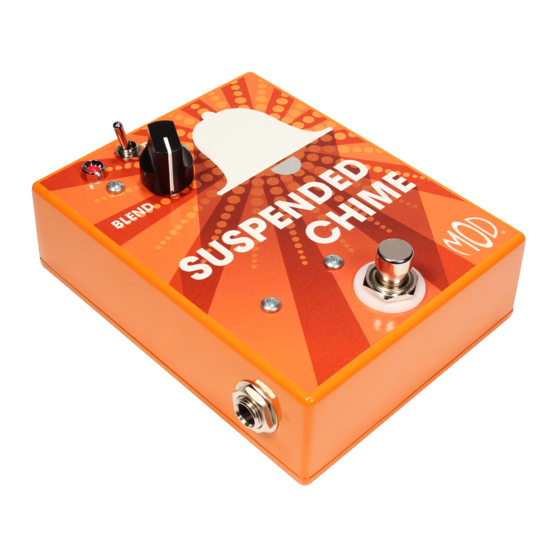Advertisement
The Suspended Troubleshooting Supplement
After thoroughly double-checking your connections, the next step is
to take DC voltage measurements to help locate problem areas.
Using a volt meter, connect the ground side lead of the meter to any
ground point on the pedal. One ground point would be the input or
output jack's sleeve lug. The other volt meter lead will be used to
measure DC voltages at the test points listed here.
If you are using only a battery for power, be sure to
plug a guitar cable into the input jack when taking
measurements. Any major differences from the
voltages listed should indicate a problem area.
DC Test Points
A = 9.2 VDC
H = 0.0 VDC
Power
BTSE L-OUT
B = 6.8 VDC
I = 8.8 VDC
LED (-)
Q2 Collector
C = 5.0 VDC
J = 0.8 VDC
BTSE 5V_IN
Q2 Base
D = 7.2 VDC
K = 0.3 VDC
Q1 Collector
Q2 Emmiter
E = 2.6 VDC
Q1 Base
F = 2.0 VDC
Q1 Emitter
G = 0.0 VDC
BTSE IN-L
Measuring AC Voltages from the Guitar Signal
Once your DC voltages are in order, if your kit is still not working properly, you can
measure AC voltages along the signal path to troubleshoot further.
You will need a volt meter that can measure the small signal AC voltages that electric
guitars put out. The output signal from your guitar will likely be less than 1 V.
First, measure the output signal directly from your guitar. You can do this by plugging your
guitar cable into the guitar and leaving the other end of the cable disconnected. Connect your
meter across the disconnected ¼" plug's "tip" and "sleeve" sections. Make sure your guitar's
volume and tone controls are turned up and strum a chord. When you strum, you should see
the AC voltage reading on the meter quickly rise to some maximum value and then fall back to
0 VAC when you stop strumming and the strings are at rest.
Once you are able to measure the output signal from your guitar directly, plug the guitar into the input jack of your kit and use the AC test points to measure the guitar
signal along the signal path. Start with test point one and move along in order. You should be looking to identify the last test point where the signal seems normal and the
first test point where the signal seems unusual or where it is no longer even present.
black
5V_IN
DGND
SW4
SW3
SW2
SW1
AGND
IN-L
AGND
L-OUT
RING
2M
(1)
Input
TIP
Lettered test points are for DC
*Numbered test points are for AC
*See the schematic for control settings.
red
4 5
+
6
(B)
1
2
3
8
7
C
(C)
W
6
H
5.6K
(A)
(H)
5
9
(5)
(D)
17
4
10
C
C
(G)
Q2
(4)
16
3
(E)
B
B
Q1
(K)
(3)
E
2
12
E
(2)
(F)
14
1
13
1
4
7
2
5
8
6
9
3
¼" Jack
¼" (Mono) Plug
Sleeve
Tip
19
20
21
22
(8)
23
(I)
(J)
(6)
(7)
26
SLEEVE
(9)
Output
TIP
Tip
Spring
Tip
Terminal
(Output)
Sleeve
Terminal
(Ground)
Advertisement
Table of Contents

Summary of Contents for Mod Suspended Chime
- Page 1 The Suspended Troubleshooting Supplement black After thoroughly double-checking your connections, the next step is to take DC voltage measurements to help locate problem areas. 5V_IN Using a volt meter, connect the ground side lead of the meter to any ground point on the pedal. One ground point would be the input or DGND output jack’s sleeve lug.
- Page 2 2.2K BTSE-16FX Digital Sound Effector P-H501 P-H541 MPSA18 78L05 NPN BJT Voltage Effect Toggle 3PDT Collector Regulator Footswitch Switch Pin-side View Base Emitter 16 15 14 13 12 11 10 Copyright © 2015 by modkitsdiy.com “The Suspended Chime” (K-977) Schematic...
- Page 3 2.2K BTSE-16FX Digital Sound Effector P-H501 P-H541 MPSA18 78L05 NPN BJT Voltage Effect Toggle 3PDT Collector Regulator Footswitch Switch Pin-side View Base Emitter 16 15 14 13 12 11 10 Copyright © 2015 by modkitsdiy.com “The Suspended Chime” (K-977) Schematic...

















Need help?
Do you have a question about the Suspended Chime and is the answer not in the manual?
Questions and answers